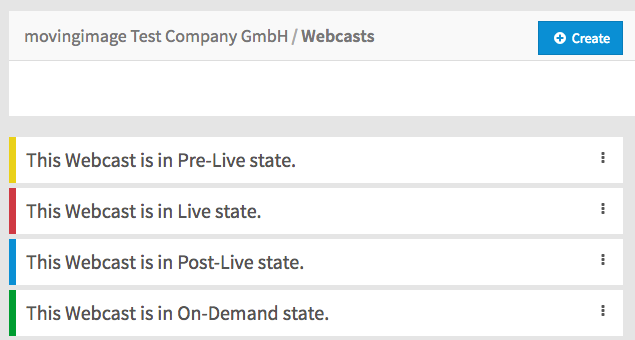Page History
The Webcast configuration determines what content is displayed to visitors, who may access the Webcast, presentation slides, languages, and a host of other settings.
You can edit an existing configuration by simply clicking on the row in the list of Webcasts, containing the relevant Webcast title.
Webcast States
A Webcast exists in one of the four
Your webcast displays audio-visual content; you can provide webcasts at any time to any target groups on the Internet. In some cases there are only audio files, but often event videos are offered in combination with PowerPoint presentations.
Webcast Status
There are different statuses, which you can configure for each stream. If for example, a URL to a promotional stream is entered for the post-live status, advertising will be played out in the webcast in this status.
| Info |
|---|
The movingimage Webcast currently supports the following streaming formats: HLS (HTTP live streaming). |
The webcast operator can put a webcast into one of the following states:
- Pre-live: In this state, a single playback video is displayed, which is useful as a teaser to the main event. Additionally, one slide can be displayed, which may contain prepared information about the upcoming live event.
- Live: In this state, the live video is streamed, and slides are synchronised by the Webcast OperatorLive: The webcast stream is open to the public during the event. For viewers, the live webcast is often the most interesting, because here, they have the possibility "to participate" directly. Viewers can interact through the chat function and ask questions, which speakers can reply to.
- Post-live: in this state, either the live video is replayed using the Digital Video Recording (DVR) feature, or a single playback video is displayed. Again, one slide can be displayed pointing to other information about the event.
- On demand: The recording of the webcast will be live Webcast is available on demand. Subsequent processing is possible, for example, you can update cue points for the presentation slides to present them at the correct time with the video., so that viewers can watch it at any time. Viewers will see all slides that were synchronised during the original live presentation, and be able to navigate through the presentation by clicking on the slides themselves.
In the list of Webcasts, each state is identified by a colored bar at the start of the row.
The Webcast Operator The webcast operator can switch from the post-live to pre-live status to test a scheduled webcast. Once a webcast has been turned to the on demand status, no change can be made.
